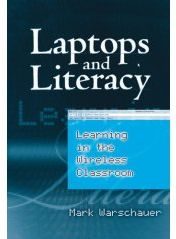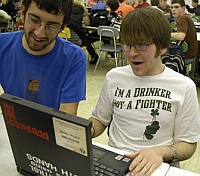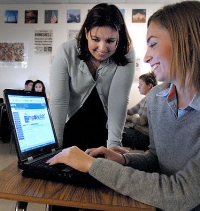Being the geek that I am, I got a copy of Mark Warschauer's latest book, Laptops and Literacy, having been a huge fan of his insightful commentary on the "digital divide" in Technology and Social Inclusion.
You might remember Mark from his New York Times article which he clarified here at OLPCNews, as well as his recent posting of a case study-like look at the Intel Classmate at the Newport Heights Elementary in Newport Beach, California.
Laptops and Literacy Overview
Laptops and Literacy is a different kind of book. Where Technology and Social Inclusion was more of a framework or theoretical book, L&L focuses on case studies of one-to-one laptop studies in the United States, focusing on some school-based programs in California and the statewide initiative in Maine which has often been help up by the OLPC Foundation as a perfect example of the power of the one laptop per child model.
Mark stays away from the OLPC project in his books. Indeed, in all of L&L, he only mentioned OLPC in passing, excluding it from his US-centric study as "unsuitable to the U.S. Market" (p.152) (to be fair, the book went to print long before Alabama got interested), and obviously before the recent announcement of OLPC America. Regardless, he drives home some important points for the OLPC project by revealing what makes a 1:1 laptop program thrive (or not) in the U.S.
Maine provides the "flagship" 1:1 laptop program for the U.S. with a statewide mandate providing laptops to all seventh graders for six years this fall (and to all eighth graders for 5, and was extended to 31 of 176 high schools in 2004). Nevertheless, Warschauer and his team of graduates are the only ones with independent research on the Maine program.
Warschauer also draws heavily from 1:1 programs in California, where the average socio-economic stats (SES) is lower in the schools he users than the Maine schools. The California schools also have much higher diversity and language challenges ("Maine is 99% White and English speaking, California is a majority-minority state ... [and] has poorly funded schools with large class sizes" (p.30)). The California 1:1 programs are individual school projects, often with the financial support of the parents, ending in both laptop- and non-laptop classes of the same material.
One to One Computing Results
Maine test scores have remained flat through their 1:1 laptop program, and there has been no evidence that laptop program improve reading or writing skills (or harm them). This can be interpreted as technology not adding anything to education, or as standardized tests failing to measure the skills learned using technology.
Laptop programs do improve students' abilities to deal with information and to collaborate, but fail to fulfill their promise of increased equality between high- and low-SES schools:
Simply put, low-SES students and school that served them were often less prepared than higher-SES students and schools to take advantage of the full capability of laptops. Students in these schools tended to have fewer language and literacy skills, and this limited what they could accomplish with laptops. [...]Warschauer stops short of concluding that laptops increase the inequalities between low- and high-SES schools from a lack of quantitative and solid outcome data. He makes it clear that he believes computers will play a near-ubiquitous role in education in the future, unlike previous attempts to inject media technology into education, which have remained at the edges (TV, radio, and film for example). This inclusion of computers will not cause education reform by itself; "Laptops are not a magic bullet to solve our educational challenges" (p. 153).For all these reasons, the implementation of laptop programs at the low-SES schools was more challenging, and the outcomes more mixed.[...] These differences between low- and high-SES schools run against one of the common rationales of laptop programs, repeated to us many times by teachers and administrators in this study: Laptop programs help overcome educational inequality.
Yet such differences are consistent with what has occurred following other reforms involving technology or media, which though targeted at low-income populations are often best exploited by the more privileged sectors that can leverage their preexisting educational, social and cultural resources. This outcome became famous in connection with the Sesame Street educational television show (Cook et al., 1975) and since has come to be known as the Sesame Street effect" (Attewell & Battle, 1999 p. 1).
Laptops as "Amplifying" tools
The examples and case studies woven throughout the book remind us that the laptops are tool, very powerful, incredible, "amplifying" tools, embedded into curricula and used in conjunction with other resources by a teacher to improve their student's education.
Laptops are not by themselves a full education system, and their usage depends heavily on engaged teachers, school administration, and sufficient support structures;
"In one case, at Freedom Middle School in California, a number of the laptops were stolen or damaged; and lacking replacement funds, the one-to-one program ended." (p.150 ).Another example from California, Mr. Molina's laptop-enabled classes at River Elementary discussed at length for its innovation (p 43-48) fell apart when Mr. Molina moved to another school; after a year of unuse, they were redistributed by the school district to his new school for him to resume using.
I also posted on this over at my blog, JonCamfield.com





Thanks for this, Jon!
FYI Two of the (critical, and quite readable) 'classics' in this area are:
Larry Cuban's 'Oversold and Underused'
Todd Oppenheimer's 'The Flickering Mind' (book-length expansion of his award-winning article in The Atlantic)
You can find both of these on the web with some inventive Google searches. And you can find lots of response (some of it rather heated) to both of these on the web.
OLPC-interested readers with patience and a long holiday weekend to spare could combine these three books with Seymour Papert's 'The Children's Machine' and Nicholas Negroponte's 'Being Digital'.
(All books are quite skimmable)
Thanks for the article.
This article thinks the problem is basically the technology is dumped on the teachers with very little in the way of training and support.
Technophobe teachers wasting millions
http://www.timesonline.co.uk/tol/news/uk/education/article3142536.ece
From looking at the forums it seems you'd need a lot of training or a computer science background to use the XO. I wonder how the teachers in the pilot program use them and if they've seen any result in test scores.
One purpose that (I thought) the XO was going to serve in developing countries, which differs from the way that laptops might be used in developed countries, is as a way to disseminate the content of textbooks or printed material via ebook technology. This is a viable alternative in places where it's difficult, impractical, or impossible to obtain print copies of textbooks.
Some of the logistics that are obstacles to textbook distribution in developing countries are unlikely to be an issue in developed countries. So the need to use a laptop in that capacity is reduced.
Interesting. I come up against similar issues in assistive tech -- people with disabilities are given devices to make their lives easier. But training is poor, the devices (communication devices especially) are hard to program, teachers and caregivers are already burdened, and the technology gathers dust.
The school where I work has fabulous technology, locked away and gathering dust.
LeslieT,
"The school where I work has fabulous technology, locked away and gathering dust."
This, ufortunatelly and for various reasons, is the most likely scenario of what will happen to Classmates in the developing countries and the 'lucky' students who _will_ 'use' them during classes will be engaging in "meaningfull educational activities", to use Warschauer's description, using MS Word and Powerpoint...
OLPC, of course, focuses on children directly and your great report [1] on your own observations of kids with special needs using XO's activities in that challenging environment (somehow I don't think Classmate would 'survive' your 'classes' :) confirms many of the OLPC principles [2]. You didn't mention using eBooks - thanks to XO e-reader like quality screen this should be quite an enjoyable experience [3] as well and there are plenty of free eBooks for children available already...
[1] LesleyT,January 16, 2008, 'Using Wayan's XO with kids -- battle report'
( http://olpcnews.com/forum/index.php?PHPSESSID=0522d736a0d21d10e019d00fddada9d2&topic=1558.msg11382#msg11382 )
[2] OLPC - Core principles
( http://laptop.org/vision/mission/ )
[3] TeleRead: Bring the E-Books Home
( http://www.teleread.org/blog/2008/01/13/the-olpc-laptop-as-a-promising-school-and-library-machine-plus-detailed-e-reading-tips-for-people-lucky-enough-to-own-xos-already/ )
This discussion confirms my own believe that the classroom is a place to teach. That is the place where teachers and students communicate.
Technology has a place in the classroom when it helps in this communication. Just as a classroom is no place to READ a book or LEARN word lists, it is also not the place to work on a computer.
Students LEARN mostly outside of the classroom.
It is outside of the classroom where students practise, do root learning, read, and write. It is there that technology can help by giving students access to much more materials and applications that can help in practicing and learning. Moreover, electronic communications can help enormously in peer tutoring and out-of-classroom contacts between students and between teacher and student.
(before I repeat what I wrote before, see:)
http://www.olpcnews.com/use_cases/education/olpc_xo_improve_teachers.html
http://www.olpcnews.com/use_cases/education/olpc_effective_violin.html
My interpretation of these results is that 1-1 laptop programs will only help if they give the students access to resources they did not have before (books, crucial applications, communication means). And this access should be AT HOME.
In the developed world, most children already have access to books (libraries), telephone, television, radio, video/DVD, computers, and the internet. They also have full-time access to teachers and classrooms. We can indeed question what the added benefit of a laptop is.
Most crucially, I didn't see whether these students could take the laptops home or whether they got internet access at home. These are the two crucial factors in the OLPC program. The whole aim of the OLPC is to get students a computer and connectivity AT HOME.
Now move to the developing world. Lack of teachers, lack of books, lack of communication. So children are outside of the classroom most of the time, and in the classroom, there are too many children for a teacher to address the needs of most children. I will quote myself:
"But it is clear, that if half the group can master a certain subject matter on their own, the teacher can devote twice as much time to those students that cannot master it on their own. So, the OLPC tries to increase teacher efficiency and other aspects of educational inefficiencies (eg, distribution of books)."
Again, I think that 1-1 laptop projects can make a difference in the developed world only if they give students resources they didn't have before. Eg, only if they reach students at home that do not have access to books, computers, or internet. In the classroom, teachers should teach, and not watch students doing their homework.
Winter
Webcast highlights low-cost computing options
Ultra-portable computers (UPCs) were the focus as ed-tech experts discussed the ‘quest for a $100 device’
http://www.eschoolnews.com/news/top-news/index.cfm?&i=50410
Lemon Grove School District erases the digital divide by providing every middle school student with and e-Pad and broadband internet access at both school and home.
http://lemongroveschools1.net/13411012137296360/site/default.asp?13411012137296360Nav=|&NodeID=286
Civilian,
"Webcast highlights low-cost computing options
...Lemon Grove School District erases the digital divide by providing every middle school student with and e-Pad..."
Thanks for the interesting links. The school doesn't "provide" (to use your strict definition from another post ;) the students with laptops - they, or rather their parents, have to buy them for $1,500 each - at 15X the cost of an XO, e-Pads are massively more expensive and the sources don't list what advantages, if any, they offer (they seem to use it mainly as a word processor and e-reader) over OLPC XOs.
$1,500 per laptop is, of course, out of the question in the developing world (Wayan wrote extensively how even $200 could be hardly affordable in some places) and even majority of schools in the developed world - given what what we know about XO unmatched ability as a e-reader (not to mention any other), it seems that the school in Birmingham is getting a much better tool for a fraction of a cost:
Birmingham, Alabama schools getting 15000 OLPC XOs
( http://www.intechnews.com/2007/12/06/birmingham-alabama-schools-getting-15000-olpc-xos/ )
Delphi,
You're right, it took a lot of digging to find out those things cost over $1000. I didn't see that the parents had to buy them directly, I thought it came out of the education budget, so everybody pays out of property taxes. You're right, the XO seems to be a much better deal than this. They could give each kid 3 and still come out ahead.
My point was how American schools are looking at technology, what kind of things they're doing and what tools they're using.
I would like to get a lap top for my 10 year old niece. She lives in San Marcos CA. Her parents are barely surviving and will more than likely lose their house. How can I get her one?
You could get an XO computer via Ebay. $235.00 is the cost with free shipping.
http://cgi.ebay.com/OLPC-XO-Laptop-Newest-Software-One-Laptop-Per-Child_W0QQitemZ190281207442QQcmdZViewItemQQptZLaptops_Nov05?hash=item190281207442&_trksid=p3286.c0.m14&_trkparms=66%3A2%7C65%3A1%7C39%3A1%7C240%3A1318